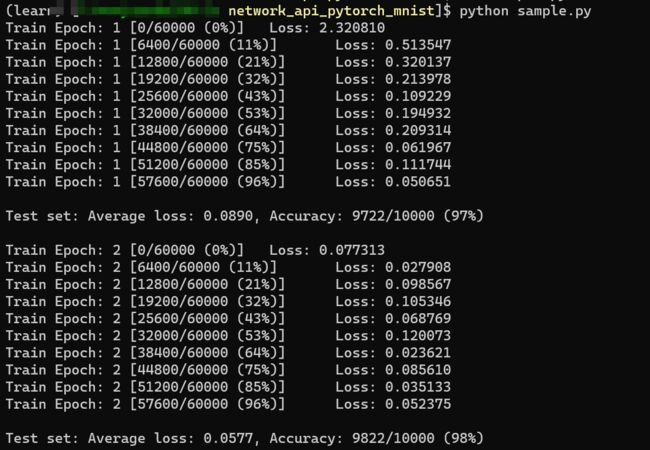TensorRt推理加速框架Python API服务器部署教程以及运行Helloworld程序
一、确认cuda工具包和n卡相关驱动是否安装
在终端中输入以下命令:
nvcc -V
nvidia-smi
如果出现即为成功,我在这里就不去介绍怎么下载cuda和驱动怎么下载了,大家可以看一下网上的其他安装教程

二、pip安装tensorRT API
此步骤在python的虚拟环境下进行:
python3 -m pip install --upgrade tensorrt
三、验证tensort库安装结果
>>> import tensorrt
>>> print(tensorrt.__version__)
8.6.1
>>> assert tensorrt.Builder(tensorrt.Logger())
[11/04/2023-11:19:33] [TRT] [W] CUDA lazy loading is not enabled.
Enabling it can significantly reduce device memory usage and speed up
TensorRT initialization.
See "Lazy Loading" section of CUDA documentation https://docs.nvidia.com/cuda/cuda-c-programming-guide/index.html#lazy-loading
四、安装Cuda-python
这里如果遇到网络问题可以加上清华源-i [https://pypi.tuna.tsinghua.edu.cn/simple](https://pypi.tuna.tsinghua.edu.cn/simple)
pip install cuda-python
五、验证cuda-python是否安装成功
进入python,如果能成功导入库,则成功安装开库
python
import cuda
六、克隆TensorRT HelloWorld程序
项目地址:https://github.com/NVIDIA/TensorRT/tree/main/samples/python/network_api_pytorch_mnist
(1)克隆整个项目
git clone https://github.com/NVIDIA/TensorRT.git
这里如果网络不行,可以直接上github下载zip文件,一样的
(2)进入pytorch版本的例子目录,安装依赖
cd TensorRT/samples/python/network_api_pytorch_mnist
pip install -r requirements.txt

这里面包含了两个python源代码文件,其中model.py是一个卷积神经网络的代码,sample.py是调用这个网络对minist数据集进行训练预测的代码,并将训练好的模型转换文tensorRT的格式进行推理。
(3)运行sample.py文件
python sample.py
运行上述命令后,会产生以下输出:
训练过程:

最终结果:
![]()
**此时,你就已经成功运行了tensorRT的pytorch版本的HelloWorld程序!**下面我们对这个HelloWorld进行深入分析。
六、代码分析-Todo
这个样例采用了经典的mnist数据集,它是一些单通道的二维图像组成的数据集,可视化后如下:

从下述代码,可以知道,作者构造了一个由两个卷积层和两个全连接层组成的简单神经网络,用来训练在mnist数据集上的预测模型,并且提供了get_weights方法,方便下载训练好的参数。
import torch
import torch.nn as nn
import torch.nn.functional as F
import torch.optim as optim
from torchvision import datasets, transforms
from torch.autograd import Variable
import numpy as np
import os
from random import randint
# 这是一个简单的神经的网络,由两个卷积层和两个全连接层组成
# Network
class Net(nn.Module):
def __init__(self):
super(Net, self).__init__()
self.conv1 = nn.Conv2d(1, 20, kernel_size=5)
self.conv2 = nn.Conv2d(20, 50, kernel_size=5)
self.fc1 = nn.Linear(800, 500)
self.fc2 = nn.Linear(500, 10)
def forward(self, x):
x = F.max_pool2d(self.conv1(x), kernel_size=2, stride=2)
x = F.max_pool2d(self.conv2(x), kernel_size=2, stride=2)
x = x.view(-1, 800)
x = F.relu(self.fc1(x))
x = self.fc2(x)
return F.log_softmax(x, dim=1)
# 这个类主要实现用上述网络结构来训练的功能
class MnistModel(object):
def __init__(self):
# 一系列超参数
self.batch_size = 64
self.test_batch_size = 100
self.learning_rate = 0.0025
self.sgd_momentum = 0.9
self.log_interval = 100
# 加载mnist的训练数据和测试数据
self.train_loader = torch.utils.data.DataLoader(
datasets.MNIST(
"/tmp/mnist/data",
train=True,
download=True,
transform=transforms.Compose([transforms.ToTensor(), transforms.Normalize((0.1307,), (0.3081,))]),
),
batch_size=self.batch_size,
shuffle=True,
num_workers=1,
timeout=600,
)
self.test_loader = torch.utils.data.DataLoader(
datasets.MNIST(
"/tmp/mnist/data",
train=False,
transform=transforms.Compose([transforms.ToTensor(), transforms.Normalize((0.1307,), (0.3081,))]),
),
batch_size=self.test_batch_size,
shuffle=True,
num_workers=1,
timeout=600,
)
# 初始化网络对象
self.network = Net()
def learn(self, num_epochs=2):
"""这个函数用来训练网络,默认训练两轮"""
# 每一个单轮训练
def train(epoch):
# 切换到训练模式
self.network.train()
# 使用随机梯度下降法来作为优化器
optimizer = optim.SGD(self.network.parameters(), lr=self.learning_rate, momentum=self.sgd_momentum)
# 每一个batch训练数据
for batch, (data, target) in enumerate(self.train_loader):
data, target = Variable(data), Variable(target)
optimizer.zero_grad()
output = self.network(data)
loss = F.nll_loss(output, target)
loss.backward()
optimizer.step()
# 输出损失信息
if batch % self.log_interval == 0:
print(
"Train Epoch: {} [{}/{} ({:.0f}%)]\tLoss: {:.6f}".format(
epoch,
batch * len(data),
len(self.train_loader.dataset),
100.0 * batch / len(self.train_loader),
loss.data.item(),
)
)
# 测试函数
def test(epoch):
# 切换到验证模式
self.network.eval()
test_loss = 0
correct = 0
for data, target in self.test_loader:
with torch.no_grad():
data, target = Variable(data), Variable(target)
output = self.network(data)
test_loss += F.nll_loss(output, target).data.item()
pred = output.data.max(1)[1]
correct += pred.eq(target.data).cpu().sum()
test_loss /= len(self.test_loader)
# 输出测试损失
print(
"\nTest set: Average loss: {:.4f}, Accuracy: {}/{} ({:.0f}%)\n".format(
test_loss, correct, len(self.test_loader.dataset), 100.0 * correct / len(self.test_loader.dataset)
)
)
# 训练num_epochs轮
for e in range(num_epochs):
train(e + 1)
test(e + 1)
def get_weights(self):
"""返回network的权重参数"""
return self.network.state_dict()
def get_random_testcase(self):
"""从名字可以看出,这是一个从测试数据中随机抽取样本来进行推理"""
data, target = next(iter(self.test_loader))
case_num = randint(0, len(data) - 1)
test_case = data.numpy()[case_num].ravel().astype(np.float32)
test_name = target.numpy()[case_num]
return test_case, test_name
从下述代码可知,作者使用了tensorRT对使用pytorch构建的神经网络进行了再构建,没有使用到parser自动解析网络框架。随着网络层数越深,这种方式会越来越麻烦。
import os
import sys
import model
import numpy as np
import tensorrt as trt
sys.path.insert(1, os.path.join(sys.path[0], ".."))
import common
TRT_LOGGER = trt.Logger(trt.Logger.WARNING)
class ModelData(object):
INPUT_NAME = "data"
INPUT_SHAPE = (1, 1, 28, 28)
OUTPUT_NAME = "prob"
OUTPUT_SIZE = 10
DTYPE = trt.float32
def populate_network(network, weights):
# 从这个函数可以看出,这里对model.py中的网络架构又重新进行了创建,并没有使用parser来自动构建网络,如果网络层数更深,使用这种方法会非常麻烦
# Configure the network layers based on the weights provided.
input_tensor = network.add_input(name=ModelData.INPUT_NAME, dtype=ModelData.DTYPE, shape=ModelData.INPUT_SHAPE)
def add_matmul_as_fc(net, input, outputs, w, b):
assert len(input.shape) >= 3
m = 1 if len(input.shape) == 3 else input.shape[0]
k = int(np.prod(input.shape) / m)
assert np.prod(input.shape) == m * k
n = int(w.size / k)
assert w.size == n * k
assert b.size == n
input_reshape = net.add_shuffle(input)
input_reshape.reshape_dims = trt.Dims2(m, k)
filter_const = net.add_constant(trt.Dims2(n, k), w)
mm = net.add_matrix_multiply(
input_reshape.get_output(0),
trt.MatrixOperation.NONE,
filter_const.get_output(0),
trt.MatrixOperation.TRANSPOSE,
)
bias_const = net.add_constant(trt.Dims2(1, n), b)
bias_add = net.add_elementwise(mm.get_output(0), bias_const.get_output(0), trt.ElementWiseOperation.SUM)
output_reshape = net.add_shuffle(bias_add.get_output(0))
output_reshape.reshape_dims = trt.Dims4(m, n, 1, 1)
return output_reshape
conv1_w = weights["conv1.weight"].numpy()
conv1_b = weights["conv1.bias"].numpy()
conv1 = network.add_convolution(
input=input_tensor, num_output_maps=20, kernel_shape=(5, 5), kernel=conv1_w, bias=conv1_b
)
conv1.stride = (1, 1)
pool1 = network.add_pooling(input=conv1.get_output(0), type=trt.PoolingType.MAX, window_size=(2, 2))
pool1.stride = (2, 2)
conv2_w = weights["conv2.weight"].numpy()
conv2_b = weights["conv2.bias"].numpy()
conv2 = network.add_convolution(pool1.get_output(0), 50, (5, 5), conv2_w, conv2_b)
conv2.stride = (1, 1)
pool2 = network.add_pooling(conv2.get_output(0), trt.PoolingType.MAX, (2, 2))
pool2.stride = (2, 2)
fc1_w = weights["fc1.weight"].numpy()
fc1_b = weights["fc1.bias"].numpy()
fc1 = add_matmul_as_fc(network, pool2.get_output(0), 500, fc1_w, fc1_b)
relu1 = network.add_activation(input=fc1.get_output(0), type=trt.ActivationType.RELU)
fc2_w = weights["fc2.weight"].numpy()
fc2_b = weights["fc2.bias"].numpy()
fc2 = add_matmul_as_fc(network, relu1.get_output(0), ModelData.OUTPUT_SIZE, fc2_w, fc2_b)
fc2.get_output(0).name = ModelData.OUTPUT_NAME
network.mark_output(tensor=fc2.get_output(0))
def build_engine(weights):
# For more information on TRT basics, refer to the introductory samples.
builder = trt.Builder(TRT_LOGGER)
network = builder.create_network(common.EXPLICIT_BATCH)
config = builder.create_builder_config()
runtime = trt.Runtime(TRT_LOGGER)
config.max_workspace_size = common.GiB(1)
# Populate the network using weights from the PyTorch model.
populate_network(network, weights)
# Build and return an engine.
plan = builder.build_serialized_network(network, config)
return runtime.deserialize_cuda_engine(plan)
# Loads a random test case from pytorch's DataLoader
def load_random_test_case(model, pagelocked_buffer):
# Select an image at random to be the test case.
img, expected_output = model.get_random_testcase()
# Copy to the pagelocked input buffer
np.copyto(pagelocked_buffer, img)
return expected_output
def main():
common.add_help(description="Runs an MNIST network using a PyTorch model")
# 训练pytorch模型
mnist_model = model.MnistModel()
mnist_model.learn()
# 训练结束后,可以获得训练后的权重字典
weights = mnist_model.get_weights()
# 使用训练好的权重来构建tensorrt的引擎对象
engine = build_engine(weights)
# Build an engine, allocate buffers and create a stream.
# For more information on buffer allocation, refer to the introductory samples.
inputs, outputs, bindings, stream = common.allocate_buffers(engine)
context = engine.create_execution_context()
# 随机抽取推理样本,保存在inputs中,case_num是抽出的样本的真实值
case_num = load_random_test_case(mnist_model, pagelocked_buffer=inputs[0].host)
# For more information on performing inference, refer to the introductory samples.
# The common.do_inference function will return a list of outputs - we only have one in this case.
# 开始推理,并产生推理结果output
[output] = common.do_inference_v2(context, bindings=bindings, inputs=inputs, outputs=outputs, stream=stream)
pred = np.argmax(output)
# 清除缓存
common.free_buffers(inputs, outputs, stream)
# 输出真实值
print("Test Case: " + str(case_num))
# 输出测试值
print("Prediction: " + str(pred))
if __name__ == "__main__":
main()

